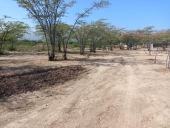Hi everyone,
After repeatedly finding myself at permies after various searches i've started discovering this site and forum. Its excellent - thank you!
Me and my wife are just starting out with an acre of land here in Mato Grosso Brazil. I'm currently reading Bill Mollison's designers manual and lots of stuff on the internet but i'm getting really muddled about how to go about things.
Heres some information:
*Mato Grosso is a cerrado/savanna but lies really really close to where the amazon WAS.
*We have 1 acre. We want a polyculture food forest /garden... everything!
*Food production for selling is not a priority... its an idea/possibility.
*No domestic animals except for neighbors dogs. We are keen on chickens.
*From what i can tell we have 3 types of earth. A fine earth with high clay content, a fine pebble mix and extremely stoney which unfortuntely makes up for teh majority part. Its currently the dry time of year and its impossible to put a spade in. I've stopped buying stones for concrete mixes... just throw our earth over an inclined mesh to end up with the same thing!! Other than where there is regular water the earth is dry with no signs of life.
This site used to be a paddock for cattle (no chemicals). I know that a few years back a tractor had passed over everything except the large trees. Its completely dominated by 2 types of tall grass which are very aggressive.
*lots of termites - i think we have two different types... and about 10 mounds. If i leave a big pile of grass it turns into a termite mound!!
*lots of leaf cutter ants
*We've been here for almost 2 years and i've basically been worried about building the house but have definitely tried to get a few trees underway with little success.
*the site is basically flat
*theres a major river about 1500m from here
One of the problems for me is that the summer months are a monsoon season (an the odd occasion water will sit a nearly foot in the lower parts/dips) which basically turns off and then extremely dry hot winter months. Its 40 degrees (104F) these days with less than 20% humidity. So, as a crude example, when Bill in his book talks about earthshaping in the tropics and says to mound for drainage and pit for water retention what am i supposed to do??
When we arrived we disturbed very little of the natural growth - only took out the grasses what we needed too. as a result we have lots of smaller trees, a few big, and the variety is really repetitive. there are lots of beautiful native trees suitable for our climate which is good.
We have a nursery and its a constant battle with leafcutter ants - as is planting anything in the ground. I appreciate their service but i've had a guts full!!! I've learnt that if something is to survive i need to nurse it until big as possible size before i put it in the ground.
Another problem is getting hold of some of the most talked about plants like comfrey and vetiver - nothing locally so we've turned to the internet which has turned up only 1 or 2 possibilities... i'm working on this.
We
compost everything - saw dust toilet too.
The most successful thing so far has been a mulch basin from the shower/bathroom. One healthy banana and papaya and lemon tree at least!! Our new passion fruit 'wall' is taking off too.
Another problem are the grasses. they dominate everything and make so many seeds. My plan is to run a lawn mower over them mulching before they seed (end of the wet season) to slowly reduce them. but there are many other weeds that will appear in their place! Lawn grass would be so nice (but irrigation would be neaded without suitable shade which we dont have). I've thought that maybe chickens in a closed space would eat up all the tall grass/weed seeds ready for sowing lawn.
Today i've filled up with mulch our first banana circle!! with grey water from the kitchen sink.
So, from what i understand... and my strategy and thinking at the moment:
*we need to create a healthy humus on top of our 'earth' - introducing material from outside sources is not possible, no one takes their waste to the dump - they burn it. So we need to create lots of material to build this up.
*We need shade - i'm looking to pioneer species. thinking teak and balsa 'forest', a few mahogany too mixed in with the trees we already have. some bamboo. Some banana, plam, papaya circles. The living fence would also help give shade and reduce the dry winds but first attempts have been disappointing. the plant is correct for our climate but has been struggling. I have probably only enough compost to do one side of the property. (we dont have an irrigation system and i didnt plant the plantlings at the beginning of the wet season - lesson learnt)
*we need ground cover - i dont know. The wet season becomes a jungle and when dry everything dries up leaving only the hardy tall grasses and exposed dirt. Due to extreme fire risk i've taken a weed eater to it all and left the layer to decompose. The edges of the property have to be clear to prevent fire entering. Another reason for the living fence.
*i'm investigating earthshaping, mounds ridges pits and swales but currently not sure what i can apply to our climate - work in progress.
Our priorities:
A living fence
Shade
Shutting out the grasses
Irrigation (we can afford it now where previously couldnt - got given 100m of hose to get started!)
Things for the future:
I'm really excited about planting cafe and cacao but all the trees here loose there leaves in august so i need to find trees that dont loose their leaves
a natural pool
a nursery to produce and sell.
Well thanks for reading if you got this far! You deserve a coffee/tea!
Any help or comments would be greatly appreciated. Obviously if you need more info just ask.
Thanks,
Mike and Pri





































